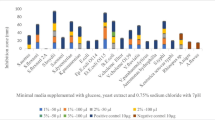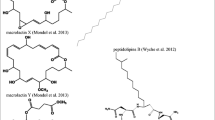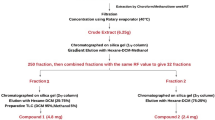Abstract
One solution to the global crisis of antibiotic resistance is the discovery of novel antimicrobial compounds for clinical application. Marine organisms are an attractive and, as yet, relatively untapped resource of new natural products. Cell extracts from the marine diatom, Phaeodactylum tricornutum, have antibacterial activity and the fatty acid, eicosapentaenoic acid (EPA), has been identified as one compound responsible for this activity. During the isolation of EPA, it became apparent that the extracts contained further antibacterial compounds. The present study was undertaken to isolate these additional antibacterial factors using silica column chromatography and reverse-phase high-performance liquid chromatography. Two antibacterial fractions, each containing a pure compound, were isolated and their chemical structures were investigated by mass spectrometry and nuclear magnetic resonance spectroscopy. The antibacterial compounds were identified as the monounsaturated fatty acid (9Z)-hexadecenoic acid (palmitoleic acid; C16:1 n-7) and the relatively unusual polyunsaturated fatty acid (6Z, 9Z, 12Z)-hexadecatrienoic acid (HTA; C16:3 n-4). Both are active against Gram-positive bacteria with HTA further inhibitory to the growth of the Gram-negative marine pathogen, Listonella anguillarum. Palmitoleic acid is active at micro-molar concentrations, kills bacteria rapidly, and is highly active against multidrug-resistant Staphylococcus aureus. These free fatty acids warrant further investigation as a new potential therapy for drug-resistant infections.





Similar content being viewed by others
References
Allen EJ, Nelson EW (1910) On the artificial culture of marine plankton organisms. J Mar Biol Assoc UK 8:421–474
Bergsson G, Arnfinnsson J, Steingrímsson Ó, Thormar H (2001) Killing of Gram-positive cocci by fatty acids and monoglycerides. APMIS 109:670–678
Borowitzka MA (1995) Microalgae as sources of pharmaceuticals and other biologically active compounds. J Appl Phycol 7:3–15
Borst P, Loos JA, Christ EJ, Slater EC (1962) Uncoupling activity of long-chain fatty acids. Biochim Biophys Acta 62:509–518
Budge SM, Parrish CC (1999) Lipid class and fatty acid composition of Pseudo-nitzschia multiseries and Pseudo-nitzschia pungens and effects of lipolytic enzyme deactivation. Phytochemistry 52:561–566
Centers for Disease Control and Prevention (2002) Staphylococcus aureus resistant to vancomycin—United States, 2002. MMWR 51:565–567
Clarke SR, Mohamed R, Bian L, Routh AF, Kokai-Kun JF, Mond JJ, Tarkowski A, Foster SJ (2007) The Staphylococcus aureus surface protein isdA mediates resistance to innate defenses of human skin. Cell Host Microbe 1:1–14
Cooper S, Battat A, Marsot P, Sylvestre M (1983) Production of antibacterial activities by two Bacillariophyceae grown in dialysis culture. Can J Microbiol 29:338–341
Cooper SF, Battat A, Marsot P, Sylvestre M, Laliberté C (1985) Identification of antibacterial fatty acids from Phaeodactylum tricornutum grown in dialysis culture. Microbios 42:27–36
Cragg GM, Newman DJ, Snader KM (1997) Natural products in drug discovery and development. J Nat Prod 60:52–60
Cutignano A, d’Ippolito G, Romano G, Lamari N, Cimino G, Febbraio F, Nucci R, Fontana A (2006) Chloroplastic glycolipids fuel aldehyde biosynthesis in the marine diatom Thalassiosira rotula. ChemBioChem 7:450–456
Desbois AP, Mearns-Spragg A, Smith VJ (2008) A fatty acid from the diatom Phaeodactylum tricornutum is antibacterial against diverse bacteria including multi-resistant Staphylococcus aureus (MRSA). Mar Biotechnol doi:https://doi.org/10.1007/s10126-008-9118-5
Duff DCB, Bruce DL, Antia NJ (1966) The antibacterial activity of marine planktonic algae. Can J Microbiol 12:877–884
Faulkner DJ (2002) Marine natural products. Nat Prod Rep 19:1–48
Findlay JA, Patil AD (1984) Antibacterial constituents of the diatom Navicula delognei. J Nat Prod 47:815–818
Galbraith H, Miller TB (1973) Physicochemical effects of long chain fatty acids on bacterial cells and their protoplasts. J Appl Bacteriol 36:647–658
Harvey A (2000) Strategies for discovering drugs from previously unexplored natural products. Drug Discov Today 5:294–300
Jamieson GR, Reid EH (1971) The occurrence of hexadeca-7,10,13-trienoic acid in the leaf lipids of angiosperms. Phytochemistry 10:1837–1843
Jensen PR, Fenical W (1994) Strategies for the discovery of secondary metabolites from marine bacteria: ecological perspectives. Annu Rev Microbiol 48:559–584
Jüttner F (2001) Liberation of 5,8,11,14,17-eicosapentaenoic acid and other polyunsaturated fatty acids from lipids as a grazer defense reaction in epilithic diatom biofilms. J Phycol 37:744–755
Kabara JJ, Swieczkowski DM, Conley AJ, Truant JP (1972) Fatty acids and derivatives as antimicrobial agents. Antimicrob Agents Chemother 2:23–28
Kabara JJ, Conley AJ, Swieczkowski DM, Ismail IA, Lie Ken Jie M, Gunstone FD (1973) Antimicrobial action of isomeric fatty acids on group A Streptococcus. J Med Chem 16:1060–1063
Kabara JJ, Vrable R, Lie Ken Jie MSF (1977) Antimicrobial lipids: natural and synthetic fatty acids and monoglycerides. Lipids 12:753–759
Kellam SJ, Walker JM (1989) Antibacterial activity from marine microalgae in laboratory culture. Br Phycol J 24:191–194
Knapp HR, Melly MA (1986) Bactericidal effects of polyunsaturated fatty acids. J Infect Dis 154:84–94
Lacey RW, Lord VL (1981) Sensitivity of staphylococci to fatty acids: novel inactivation of linolenic acid by serum. J Med Microbiol 14:41–49
Laser H (1952) Adaption of Bacillus subtilis to fatty acids. Biochem J 51:57–62
Li X, Fan X, Han L, Lou Q (2002) Fatty acids of some algae from the Bohai Sea. Phytochemistry 59:157–161
Miller RD, Brown KE, Morse SA (1977) Inhibitory activity of fatty acids on the growth of Neisseria gonorrhoeae. Infect Immun 17:303–312
Moss CW, Daneshvar MI (1992) Identification of some uncommon monounsaturated fatty acids of bacteria. J Clin Microbiol 30:2511–2512
Norton TA, Melkonian M, Andersen RA (1996) Algal biodiversity. Phycologia 35:308–326
Parrish CC, Wangersky PJ (1987) Particulate and dissolved lipid classes in cultures of Phaeodactylum tricornutum grown in cage culture turbidostats with a range of nitrogen supply rates. Mar Ecol Prog Ser 35:119–128
Pesando D (1990) Antibacterial and antifungal activities of marine algae. In: Akatsuka I (ed) Introduction to applied phycology. SPB Academic Publishing B.V., The Hague, pp 3–26
Pohnert G (2002) Phospholipase A2 activity triggers the wound-activated chemical defense in the diatom Thalassiosira rotula. Plant Physiol 129:103–111
Sheu CW, Freese E (1972) Effects of fatty acids on growth and envelope proteins of Bacillus subtilis. J Bacteriol 111:516–524
Shimizu Y (1996) Microalgal metabolites: a new perspective. Annu Rev Microbiol 50:431–465
Shin SY, Bajpai VK, Kim HR, Kang SC (2007) Antibacterial activity of eicosapentaenoic acid (EPA) against food borne and food spoilage microorganisms. LWT 40:1515–1519
Srinivasan A, Dick JD, Perl TM (2002) Vancomycin resistance in staphylococci. Clin Microbiol Rev 15:430–438
Sun CQ, O’Connor CJ, Roberton AM (2003) Antibacterial actions of fatty acids and monoglycerides against Helicobacter pylori. FEMS Immunol Med Microbiol 36:9–17
Thormar H, Isaacs CE, Brown HR, Barshatzky MR, Pessolano T (1987) Inactivation of enveloped viruses and killing of cells by fatty acids and monoglycerides. Antimicrob Agents Chemother 31:27–31
Walton MJ, Henderson RJ, Pomeroy PP (2000) Use of blubber fatty acid profiles to distinguish dietary differences between grey seals Halichoerus grypus from two UK breeding colonies. Mar Ecol Prog Ser 193:201–208
Wang L-L, Johnson EA (1992) Inhibition of Listeria monocytogenes by fatty acids and monoglycerides. Appl Environ Microbiol 58:624–629
Zheng CJ, Yoo JS, Lee TG, Cho HY, Kim YH, Kim WG (2005) Fatty acid synthesis is a target for antibacterial activity of unsaturated fatty acids. FEBS Lett 579:5157–5162
Acknowledgements
The authors thank Dr. Mike Walton for assistance during DMDS adducts synthesis and Ms. Caroline Horsburgh (School of Chemistry, University of St. Andrews) and Dr. Catherine Botting (School of Biology, University of St. Andrews) for mass spectrometry. Strains of B. cereus, B. weihenstephanensis, C. glabrata, C. neoformis, MRSA252 and S. cerevisiae were gifted by Dr. Peter Coote (School of Biology, University of St. Andrews) and Prof. Simon Foster (Department of Molecular Biology and Biotechnology, University of Sheffield) gifted the S. aureus strain. This work was funded by a BBSRC studentship (BBS/S/M/2003/10490) with additional financial support from Dr. Andrew Mearns-Spragg (CEO, Aquapharm Bio-Discovery Ltd.).
Author information
Authors and Affiliations
Corresponding author
Rights and permissions
About this article
Cite this article
Desbois, A.P., Lebl, T., Yan, L. et al. Isolation and structural characterisation of two antibacterial free fatty acids from the marine diatom, Phaeodactylum tricornutum . Appl Microbiol Biotechnol 81, 755–764 (2008). https://doi.org/10.1007/s00253-008-1714-9
Received:
Revised:
Accepted:
Published:
Issue Date:
DOI: https://doi.org/10.1007/s00253-008-1714-9




